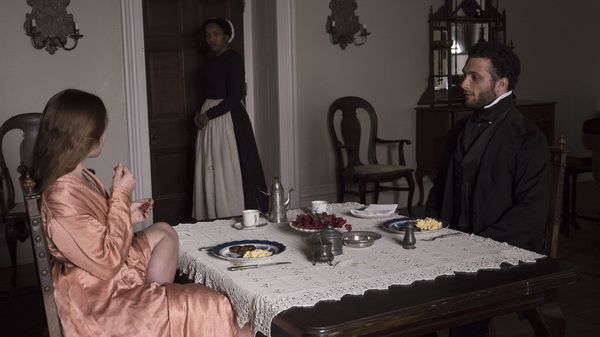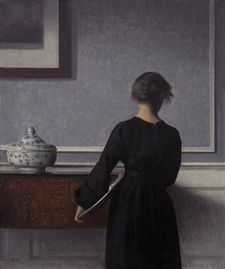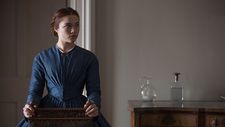 |
| Florence Pugh, Naomi Ackie and Cosmo Jarvis in Lady Macbeth. William Oldroyd: 'I thought, why haven’t we seen this on film' |
“We wondered for a while if we should contemporise the story,” said Oldroyd when I caught up with him in San Sebastian, where his film had just won the FIPRESCI prize. “It was written in 1865 but the story felt very modern because of what she did. But we thought there was something about the period that was very isolated, especially because it’s set in Russia.”
 |
| William Oldroyd says Vilhelm Hammershøi paints 'a lot of faceless women and I thought, ‘This could be Katherine’.' |
Oldroyd added: “Because so many films of that period are interested in the Victoriana – the heavy drapes, the dark wood, lots of ornaments – stuffy, really – I was interested in trying to portray a different sort of austerity.
“In the north-east, I think the light is quite different from London – a northern European light – it made me think of Scandinavia. There’s a Danish artist, Vilhelm Hammershøi, who has a lot of very interesting interiors, where women are standing looking out of windows and facing away from the viewer. A lot of faceless women and I thought, ‘This could be Katherine’. So we looked at those paintings. When you’re in the house, it’s quite light. So, rather than go against that, we thought why don’t we try to use that, but then suck all the air out of it?”
The film was shot on the Lampton Estate, near Chester le Street. Oldroyd says he chose the area because he was looking for the same sense of isolation that the original Russian novel possessed.
“We thought there are large parts of the Northumberland national park and the north Pennines that feel like they haven’t really changed much in 150 years, so we went there,” he said. “And I knew Durham because I went to university there.
“At one point, we thought why don’t we film in the National Park? In one of the big houses, so that when we go out of the door, we’ve got the hills. But we realised that lack of mobile phone coverage and getting a crew to travel for more than an hour a day would be difficult.”
The film is also notable for its use of both white and black actors in various roles, with Naomi Ackie particularly impressive in her feature debut as Katherine’s maid Anna. “I discussed this with casting director Shaheen Baig and Alice Birch, who wrote the screenplay, and we decided that, for all parts, we would have blind casting,” says Oldroyd.
“On our minds was British history from that period has a tendency to be whitewashed. We were finding a lot of photographs from the time of black families, wearing all of the gear, all the corsets and the crinolines, and these were the middle classes, people who could afford to have photographs taken, not just the servants. I thought, why haven’t we seen this on film, where are they? So we thought we should have them in the film.”
Lady Macbeth screens at New Directors/New Films on March 24 and 25, featuring Q&As with William Oldroyd. The film will be released by Altitude in the UK on April 28. The film will be released in the US by Roadside Attractions this summer.
Watch the trailer below






















